
The Australian raven is a passerine bird in the genus Corvus native to much of southern and northeastern Australia. Measuring 46–53 centimetres (18–21 in) in length, it has all-black plumage, beak and mouth, as well as strong grey-black legs and feet. The upperparts are glossy, with a purple, blue, or green sheen, and its black feathers have grey bases. The Australian raven is distinguished from the Australian crow species by its throat hackles, which are prominent in adult birds. Older adult individuals have white irises, younger adults have white irises with an inner blue rim, while younger birds have dark brown irises until fifteen months of age, and hazel irises with an inner blue rim around each pupil until age two years and ten months. Nicholas Aylward Vigors and Thomas Horsfield described the Australian raven in 1827, its species name (coronoides) highlighting its similarity with the carrion crow. Two subspecies are recognized, which differ slightly in calls and are quite divergent genetically.

The little raven is a species of the family Corvidae that is native to southeastern Australia. An adult individual is about 48–50 cm (19–19.5 in) in length, with completely black plumage, beak, and legs; as with all Australian species of Corvus, the black feathers have a grey base, and the iris of the adult bird is white . Although the little raven was first named by Gregory Mathews in 1912, it was only in 1967 that there was consensus to separate it from the Australian raven as a distinct species.
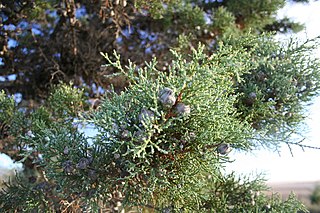
Cypress is a common name for various coniferous trees or shrubs of northern temperate regions that belong to the family Cupressaceae. The word cypress is derived from Old French cipres, which was imported from Latin cypressus, the latinisation of the Greek κυπάρισσος (kyparissos).

Anostostomatidae is a family of insects in the order Orthoptera, widely distributed in the southern hemisphere. It is named Mimnermidae or Henicidae in some taxonomies, and common names include king crickets in South Africa and weta in New Zealand. Prominent members include the Parktown prawn of South Africa, and the giant weta of New Zealand. The distribution of this family reflects a common ancestry before the fragmenting of Gondwana.
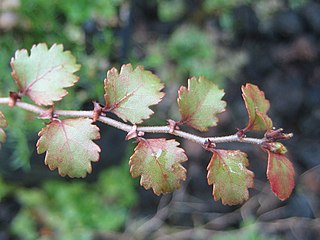
The Antarctic flora is a distinct community of vascular plants which evolved millions of years ago on the supercontinent of Gondwana. It is now found on several separate areas of the Southern Hemisphere, including southern South America, southernmost Africa, New Zealand, Australia and New Caledonia. Joseph Dalton Hooker was the first to notice similarities in the flora and speculated that Antarctica had served as either a source or a transitional point, and that land masses now separated may have formerly been adjacent.
Snook, Snooks, or Snoek may refer to:
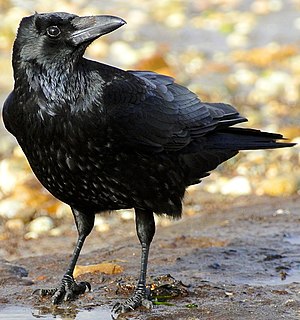
A crow is a bird of the genus Corvus, or more broadly a synonym for all of Corvus. The term "crow" is used as part of the common name of many species. Species with the word "crow" in their common name include:
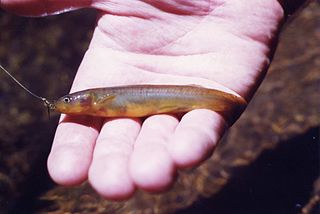
The Galaxiidae are a family of mostly small freshwater fish in the Southern Hemisphere. The majority live in Southern Australia or New Zealand, but some are found in South Africa, southern South America, Lord Howe Island, New Caledonia, and the Falkland Islands. One galaxiid species, the common galaxias, is probably the most widely naturally distributed freshwater fish in the Southern Hemisphere. They are coolwater species, found in temperate latitudes, with only one species known from subtropical habitats. Many specialise in living in cold, high-altitude upland rivers, streams, and lakes.
The Australian Chess Championship is a tournament organised by the Australian Chess Federation and held every two years. The tournament is largely restricted to Australian chess players, although it is common to allow a small number of strong overseas players to compete. The highest-scoring eligible player holds the title of Australian Chess Champion until the next tournament is held. The tournament format is normally a restricted Swiss system, and in case of a tie for first place, a playoff match or tournament is conducted.

Chrysanthemoides monilifera is an evergreen flowering shrub or small tree, usually with woolly, dull, serrate, oval leaves, but with glossy round leaves in the subsp. rotundata, belonging to the Asteraceae (daisy) family. It is native to South Africa, such as the Cape Flats Dune Strandveld habitat.
Ian or Iain is a name of Scottish Gaelic origin, ultimately derived from Hebrew Yohanan and corresponding to English John. The spelling Ian is an Anglicization of the Scottish Gaelic forename Iain. It is a very popular name in much of the English-speaking world and especially in Scotland, where it originated.

Ten Pound Poms is a colloquial term used in Australia and New Zealand to describe British citizens who migrated to Australia and New Zealand after the Second World War. The Government of Australia initiated the Assisted Passage Migration Scheme in 1945, and the Government of New Zealand initiated a similar scheme in July 1947. Ten Pound poms were called that because they only had to pay £10 in processing fees to migrate to Australia and the Commonwealth arranged for assisted passage on chartered ships and aircraft.
The Australian cricket team toured New Zealand in the 1973-74 season to play a three-match Test series against New Zealand.

Ozius truncatus, or the black finger crab or reef crab, is a crab of the family Menippidae, endemic to south eastern Australia and the North Island of New Zealand.
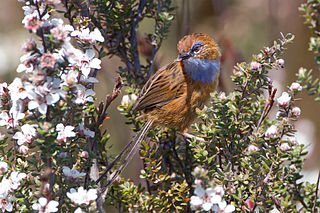
The southern emu-wren is a species of bird in the Australasian wren family, Maluridae. It is endemic to Australia. Its natural habitats are temperate forests and Mediterranean-type shrubby vegetation.
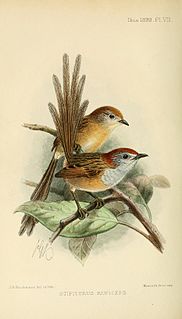
The emu-wrens (Stipiturus) are a genus of passerine birds in the Australasian wren family, Maluridae. They are found only in Australia, where they inhabit scrub, heathland and grassland. They are small birds, 12–19 cm long with the tail accounting for over half of their length. The tail has only six feathers which are loose and coarse in structure, rather like the feathers of the emu. Three species are recognised, of which the mallee emu-wren is endangered.

The rufous-crowned emu-wren is a species of bird in the Australasian wren family, Maluridae. It is endemic to Australia.

Wattle and daub is a composite building material used for making walls, in which a woven lattice of wooden strips called wattle is daubed with a sticky material usually made of some combination of wet soil, clay, sand, animal dung and straw. Wattle and daub has been used for at least 6,000 years and is still an important construction material in many parts of the world. Many historic buildings include wattle and daub construction, and the technique is becoming popular again in more developed areas as a low-impact sustainable building technique.
Lophocorona melanora is a moth of the family Lophocoronidae. It was described by Ian Francis Bell Common in 1973. It is only known from the Australian Alps in the Australian Capital Territory.














